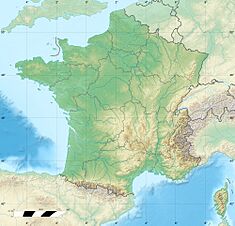Glanum Dam facts for kids
Quick facts for kids Glanum Dam |
|
|---|---|
|
Location of Glanum Dam in France
|
|
| Location | Glanum (Saint-Rémy-de-Provence), Bouches-du-Rhône, France |
| Coordinates | 43°46′17″N 4°49′44″E / 43.77139°N 4.82889°E |
| Opening date | 1st century BC |
| Dam and spillways | |
| Impounds | Vallon de Baume |
| Height | 12 m |
| Length | 18 m |
| Width (base) | 3.9 m |
| Reservoir | |
| Creates | Lac des Peiròu |
The Glanum Dam, also known as the Vallon de Baume dam, was an ancient Roman dam. It was built to provide water for the Roman town of Glanum. The remains of Glanum are located near Saint-Rémy-de-Provence in Southern France.
This dam was found south of Glanum. It was in a deep gorge within the Alpilles hills. This area was part of a Roman province called Gallia Narbonensis. Built around the 1st century BC, it is the earliest known dam of its kind. A modern dam was built in its place in 1891. This new dam now supplies water to Saint-Rémy-de-Provence.
Discovering the Ancient Dam
The remains of the Roman dam at Glanum were found in 1763. A person named Esprit Calvet made this discovery. Recent studies have taught us more about how the dam was built.
How it was Built
The original dam had two curved stone walls. Each wall was about 1 metre (3.3 ft) thick. There was a gap of about 1.5 metres (4.9 ft) between the walls. This gap was probably filled with earth and rocks.
The stone blocks were held together with metal clamps, called crampons. They also used special joints, called Cordon joints. These joints helped stop water from leaking through. At each end, the dam had supports built into the rock of the gorge. The dam stood about 6 metres (20 ft) high. It was about 3.5 metres (11 ft) thick.
Its Purpose and Design
Because of its size and location in a steep gorge, it was a true arch dam. This means it was curved like an arch. This shape helped it hold back a lot of water. The dam collected water and sent it into an aqueduct. This aqueduct then carried the water to the Roman town of Glanum.
The Modern Dam
In 1891, a new arched dam was built in the same spot. This construction unfortunately destroyed the remains of the old Roman dam. The lake created by this modern dam is called the Lac de Peirou in French. You can visit it by following the Chemin du Barrage.
See also
- List of Roman dams and reservoirs
- Roman architecture
- Roman engineering
- Dara Dam


